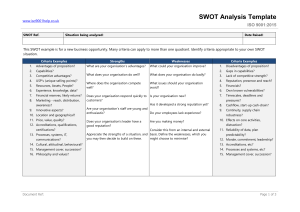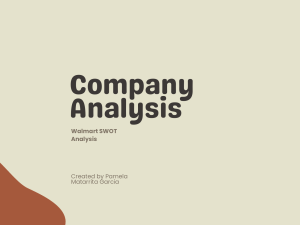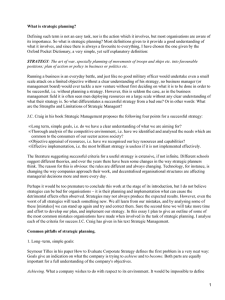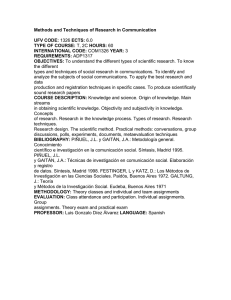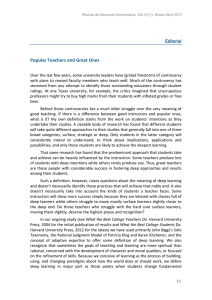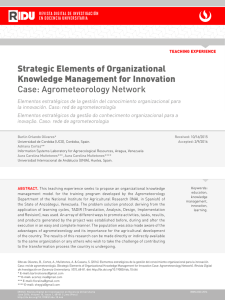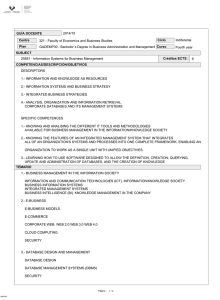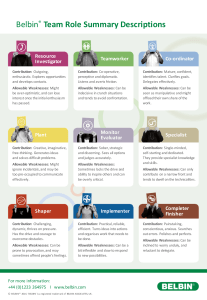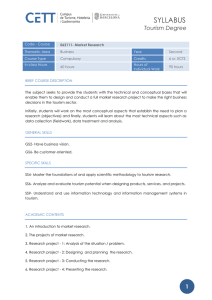Ahp-enhanced swot matrix teaching strategy
Anuncio
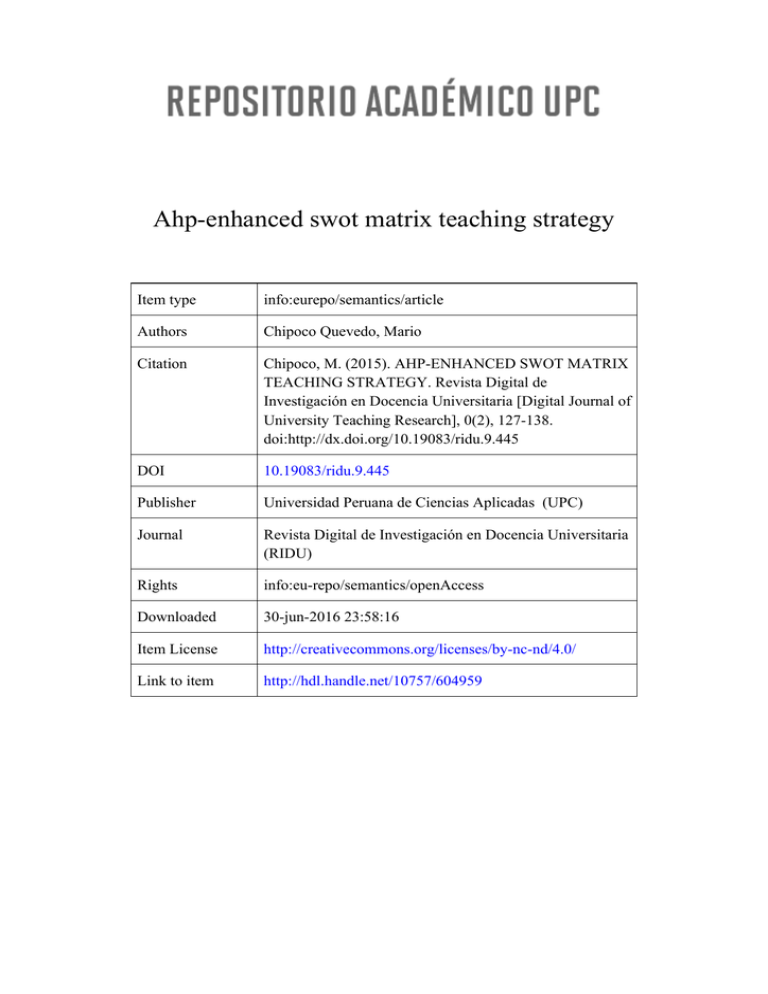
Ahp-enhanced swot matrix teaching strategy Item type info:eurepo/semantics/article Authors Chipoco Quevedo, Mario Citation Chipoco, M. (2015). AHP-ENHANCED SWOT MATRIX TEACHING STRATEGY. Revista Digital de Investigación en Docencia Universitaria [Digital Journal of University Teaching Research], 0(2), 127-138. doi:http://dx.doi.org/10.19083/ridu.9.445 DOI 10.19083/ridu.9.445 Publisher Universidad Peruana de Ciencias Aplicadas (UPC) Journal Revista Digital de Investigación en Docencia Universitaria (RIDU) Rights info:eu-repo/semantics/openAccess Downloaded 30-jun-2016 23:58:16 Item License http://creativecommons.org/licenses/by-nc-nd/4.0/ Link to item http://hdl.handle.net/10757/604959 AHP-ENHANCED SWOT MATRIX TEACHING STRATEGY ESTRATEGIA DE ENSEÑANZA DE LA MATRIZ FODA EXTENDIDA CON AHP Mario Chipoco Quevedo* Universidad Peruana de Ciencias Aplicadas, Perú Recibido: 08/10/15 Aceptado: 18/11/15 ABSTRACT The SWOT matrix is the quintessential analysis tool for business purposes, and is taught both in undergraduate and postgraduate courses. However, it is widely understood that the selection of the critical success factors (CSFs) that are included for analysis in the matrix is a very subjective and unstructured process, leaving room for bias and arbitrariness. One way to give a better foundation and support to the analysis results is by utilizing Analytic Hierarchical Process (AHP) in order to weigh the importance of CSFs in the SWOT matrix and increase reliability of the output. This paper contains the design of a strategy to teach this topic in a marketing planning course, with the addition of a useful technique to overcome the limitations of the tool. Keywords: SWOT matrix, analytic hierarchical process, teaching strategy. RESUMEN La matriz FODA es la herramienta de análisis por excelencia para fines de negocios, y se enseña en cursos de pregrado y postgrado. Sin embargo, se entiende que la elección de los factores críticos de éxito (FCEs) que se incluyen en la matriz para el análisis es un proceso muy subjetivo y no estructurado, que da cabida a sesgos y arbitrariedad. Una forma de dar una mejor base y respaldo a los resultados del análisis es mediante la utilización del Proceso Jerárquico Analítico (AHP) con el fin de ponderar la importancia de los FCEs en la matriz FODA y aumentar la fiabilidad de los resultados. Este documento contiene el diseño de una estrategia para enseñar este tema en un curso de planificación de marketing, con la adición de una técnica útil para superar las limitaciones de la herramienta. Palabras clave: matriz FODA, proceso analítico jerárquico, estrategia de enseñanza. *pcadmchi@upc.edu.pe [RIDU]: Revista Digital de Investigación en Docencia Universitaria Dic. 2015 - Año 9 - Nro.2 | LIMA (PERÚ) ISSN: 2223 - 2516 128 MARIO CHIPOCO INTRODUCTION SWOT analysis is a highly utilized tool professional studies, it is a good practice to undergraduate and postgraduate business environment. This paper provides a design of to implement strategic management processes in organizations. As such, it is included in and marketing planning courses. Even though it is widely used in academia and corporate environments, its origin is not well documented, as noted by Panagiotou (2003), and apparently, this tool originated in several places and became mainstream in the 1960s. Despite its wide utilization, SWOT analysis has notorious shortcomings, such as vagueness or lack of detail in the description of critical success factors, and it frequently relies on an oversimplified process (Panagiotou, 2003). In order to maintain the usefulness of this tool, it is necessary to follow a standard set of common sense rules and advanced techniques to achieve a proper level of analysis. Since managers and entrepreneurs usually get acquainted with this matrix during university Table 1 Strategies from SWOT analysis provide complete guidelines to teach this subject based on a more complex business such strategy for a marketing planning course. Revision of literature The basic guidelines to perform a SWOT analysis are contained in most textbooks dealing with business and marketing planning. David (2014) gave a full description of the basic methodology to perform the analysis, as part of the planning process stage where the organization´s capabilities and resources to face threats and opportunities are assessed. David indicated that the analysis work requires good intuitive judgments to identify and determine proper weights and rankings of CSFs. He also described the nine-quadrant matrix and the four types of strategies that can be derived from the SWOT matrix: SWOT matrix Strengths Opportunities Use strengths to seize opportunities Threats Use strengths to avoid threats Weaknesses Overcome weaknesses to seize opportunities Overcome weaknesses to avoid threats Note: Adapted from Strategic management: a competitive advantage approach, concepts & cases (p. 169), by F. R. David, 2014, New Jersey: Prentice Hall. Copyright 2014 by Pearson Education, Inc. David also provided common sense only a systematic method, but also creativity environment and the resources and capabilities choices of future strategies to be pursued, advice on typical situations, some sort of recipes to be applied according to the external of the organization. The election of strategies is the most important part of this process, and it is backed-up by strategic intuition (D’Alessio, 2008), because it demands not [RIDU]: Revista Digital de Investigación en Docencia Universitaria Dic. 2015 - Año 9 - Nro.2 | LIMA (PERÚ) and business instincts from managers. SWOT analysis provides strategic alternatives, or given the company’s internal strengths and weaknesses, and its external opportunities and threats (Hill, Jones & Schilling, 2014). In a large business, SWOT analysis is carried out ideally ISSN: 2223 - 2516 129 AHP-ENHANCED SWOT MATRIX TEACHING STRATEGY by a multi-disciplinary team in a workshop dedicated to the preparation of such analysis, with the objective of gaining sustainable competitive advantage (Friend & Zehle, 2004). The process of identifying strategic issues that will affect an organization’s environment at some future time is called internal environmental forecasting and it is a critical step in SWOT analysis (Rao, 2010). Addressing the marketing plan design specifically, Sainz de Vicuña (2010) said that the strengths and weaknesses must be related to competitive advantages and disadvantages, because this approach is more useful for defining a marketing strategy than the utilization of strengths and weaknesses, due to the key role of customer perspectives and degree of rivalry with competitors. The SWOT analysis must be conducted for each relevant segment of the company’s future, and it summarizes the marketing audit (McDonald, 2011). Managers must evaluate the issues within the matrix in terms of their magnitude and importance, and ideally, this evaluation should be based on customers’ perception (Ferrell & Hartline, 2011). These authors also indicate that even though it is not mandatory that the SWOT matrix be assessed quantitatively, they suggest the use of a scale to quantify how strongly the CSFs affect the firm (Ferrell & Hartline, 2011). Kotler & Keller (2015) wrote that the business units must analyze the macro- and micro-environment forces that affect their capacity to generate profit, and that a marketing opportunity is the buyers’ every need or interest that the firm can satisfy profitably. They also provided a roster of key CSFs to be assessed and valued according to their magnitude and importance. Due to a changing external environment, it is mandatory to continuously track competition and other key elements of the market system, so as to determine what patterns are developing (Vass, 2005). The limitations of the tool have been discussed and many improvements have been suggested by academic researchers. The open nature and unstructured method of SWOT offers little help to users, who are left without guidance on where to search for such variables, or what to do afterwards, in terms of how best to incorporate them in the strategy formulation (Panagiotou, 2005). Among other flaws, the following were mentioned by Coman & Ronen (2009): •No straightforward methodology is provided to identify strengths and weaknesses. •Most SWOT analyses focus on an excessive number of the organization’s strengths and weaknesses rather than on the main ones, which makes it difficult to utilize the findings to design the actions. •There is no indication of causality among the strengths and weaknesses, nor are they ranked into any hierarchy. •The SWOT analysis is typically a one- time event lacking procedures for acting upon and tracking the changes in strengths and weaknesses over the longer term. A research on 20 UK manufacturing companies carried out by Hill & Westbrook (1997) showed that the SWOT matrices contained long lists of CSFs (over 40 on average), general (often meaningless) descriptions, a failure to prioritize, no attempt to verify points, and no subsequent utilization of the outputs within the later stages of the strategy process. Due to these limitations, different frameworks have been proposed to improve the results and its utilization within organizations. Acceso al documento completo: http://hdl.handle.net/10757/604959 [RIDU]: Revista Digital de Investigación en Docencia Universitaria Dic. 2015 - Año 9 - Nro.2 | LIMA (PERÚ) ISSN: 2223 - 2516
